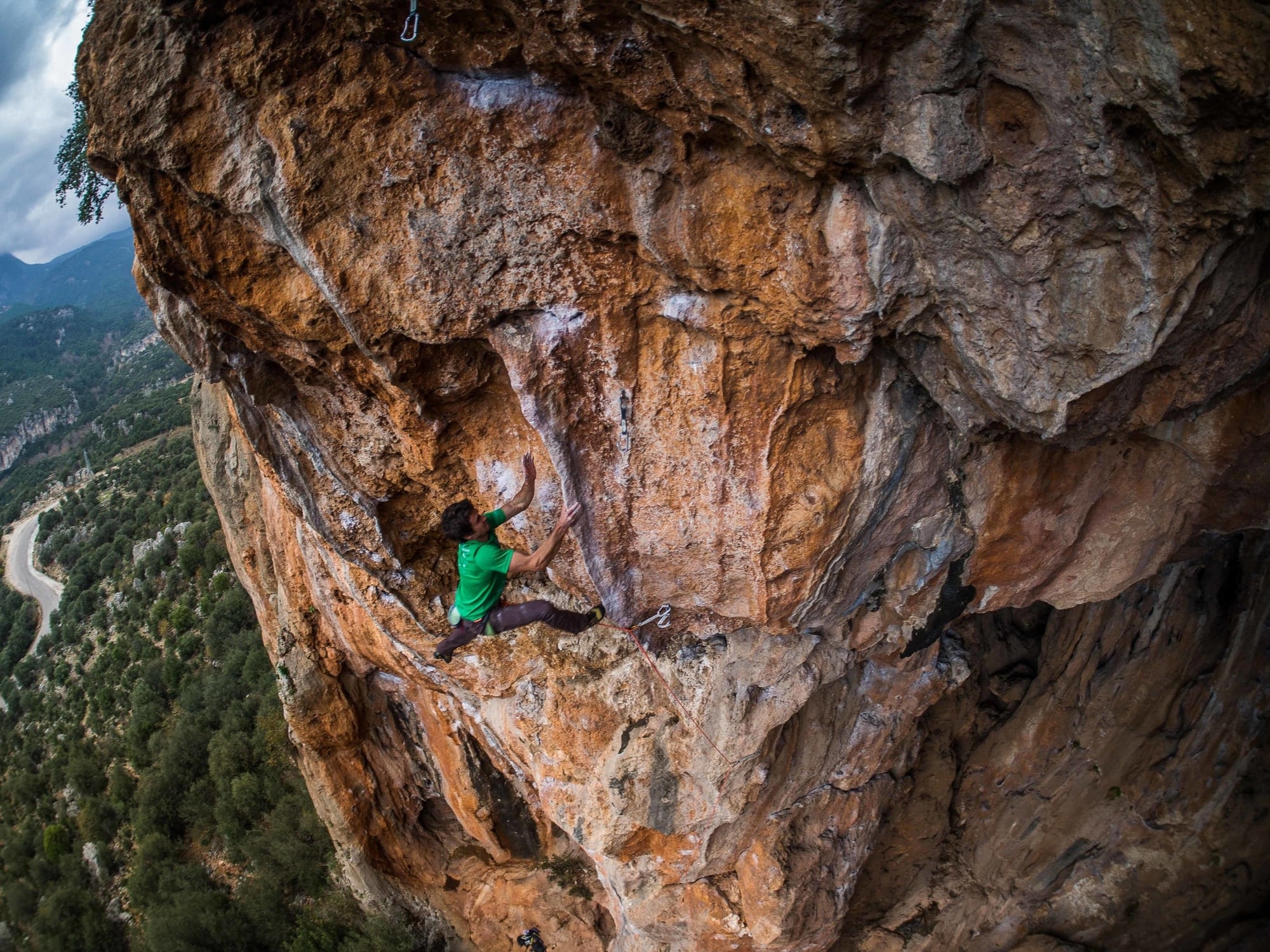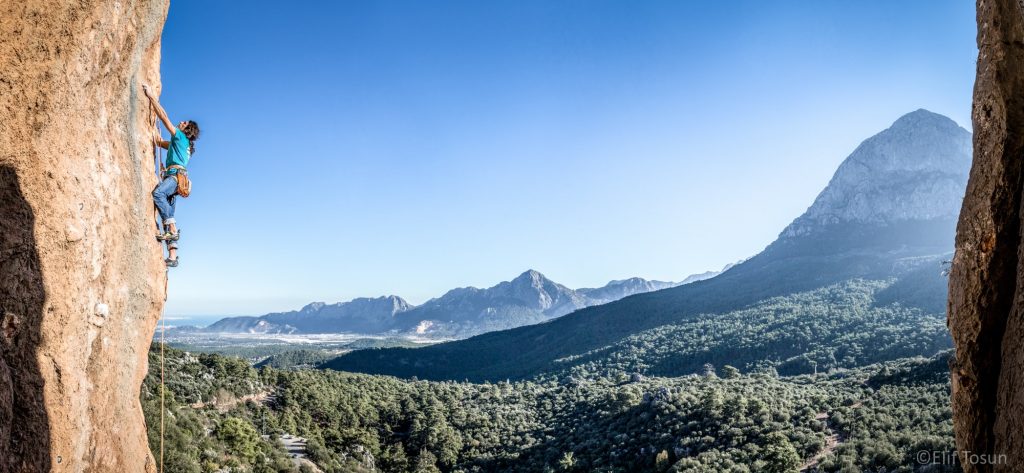
Turkish machine Mümin Karabaş in Geyikbayırı. All photos courtesy of Elif Tosun unless otherwise noted.
Turkey is truly a fantastic destination for a traveling climber; low cost of living, friendly locals, crags for every season, and a variety of climbing styles. I first saw Turkish limestone in the background of the 2015 Turkish Highline Carnival (THC) video and immediately started planning a trip.
Since my first three-week trip in February 2016, I’ve spent a cumulative 13 months climbing all over the country. The climbing community gave me so much and supported me as I explored their crags for over a year. I am grateful and indebted to the kind individuals who shared with me their traditions, cultural knowledge, and endless stoke for climbing. I want to pass along my knowledge so that more climbers will feel emboldened to explore this incredible country covered in rock. The last few years in Turkey have been tough for those whose livelihoods depend on tourism, which includes many local climbers.
Rock doesn’t give in to political pressures, so why should we?
The most renowned climbing area in the country is 15km outside of Antalya. Named for the village just above the bands of rock, Geyikbayırı is home to some 1,000 sport routes and the largest stable community of outdoor climbers in the country. While other climbing areas may not have as many routes, they rival Geyikbayırı in their stunning beauty, solid rock, and accessibility for the traveling climber.
Some climbing areas are recognized as Tırmanış Bahçeler (Climbing Gardens). Most have camping for climbers, ranging from free camping on public land to private campgrounds with tent spots, bungalows, and houses. In most towns or villages, it is possible to rent a house or apartment for under $300 a month. You might not want to leave!
Specific description of climbing style
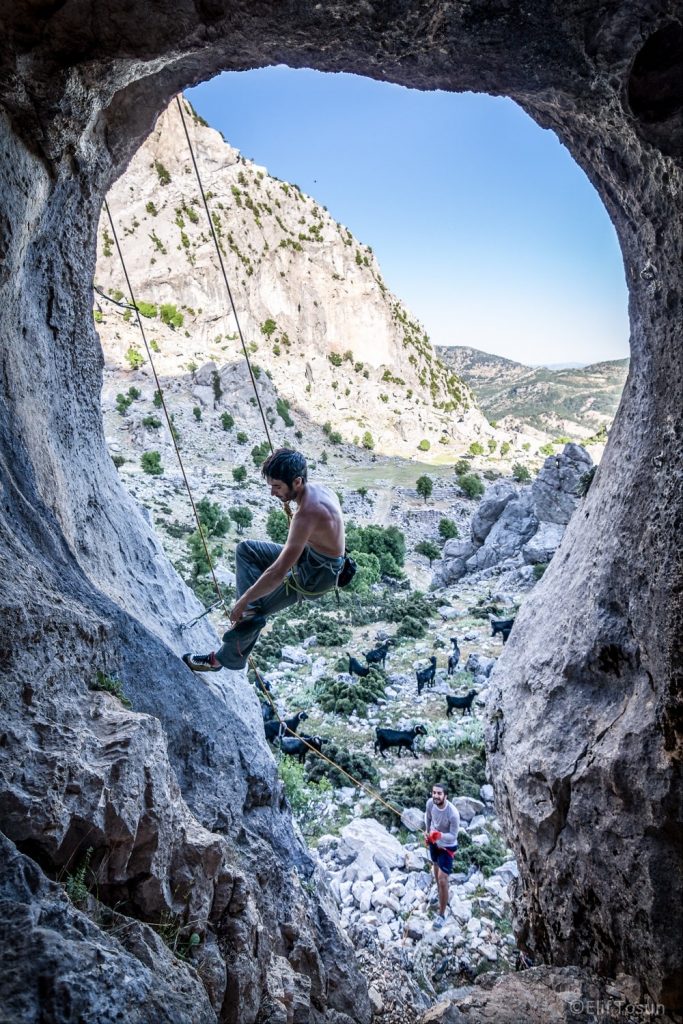
Oğuz cleaning a route in Kapıkaya.
Limestone, limestone, Mediterranean limestone.
Besides the bouldering in Bafa (granite gneiss), all the places listed below are limestone. Turkish climbing areas come in a variety of sizes, colors, and amount of traffic. Not only is there climbing year-round in Turkey, but there are areas suited for every type of climber. Vacation on the beach with climbing on the side?
Long days of alpine type 2 fun? Below are brief descriptions of just seven climbing areas:
- Aladağlar Milli Parkı
- Kapıkaya
- Kaynaklar
- Sarıkaya
- Geyikbayırı
- Çitdibi
- Bafa Gölu
Other climbing areas in Turkey such as Datça (see guide here), Çakıt (near Adana), Erzurum (ice climbing), Olympos (DWS and climbing on the beach), Karakayalar (granite near Ankara), and Geyve (near Istanbul) are not addressed individually below but the travel information applies to these areas as well.
Transportation
If you’re having trouble finding a decent price for a flight to Turkey, try flying to Europe and then taking a separate flight to Turkey. Holiday airlines provide regular service to Turkey from European cities and often go directly to cities closer to climbing areas such as Dalaman, Antalya, or Adana. Pegasus and affiliated airlines have even been known to accept climbing equipment as “sports baggage” for a much lower fee!
Busses are a safe and widely available form of travel in Turkey. Turkish climbers, especially university students, often hitchhike. While just as dangerous as anywhere, hitchhiking is an effective form of transportation in rural Turkey, where it’s a common way for villagers to get around. Marked taxis, while sometimes overpriced, are prevalent and dependable. Climber accommodations offer shuttle and transfer services as well.
One of my favorite things about traveling and climbing in Turkey is that I did not need to rent or buy a car. In Aladağlar and Datça, I rented a scooter to commute back and forth between my apartment and crag. Independent transportation can be incredibly convenient. Especially in the off-season winter months, significant deals on car rentals for over two weeks can be found online. Companies based in major cities that are not directly at the airport will usually have the best deals.
Visas
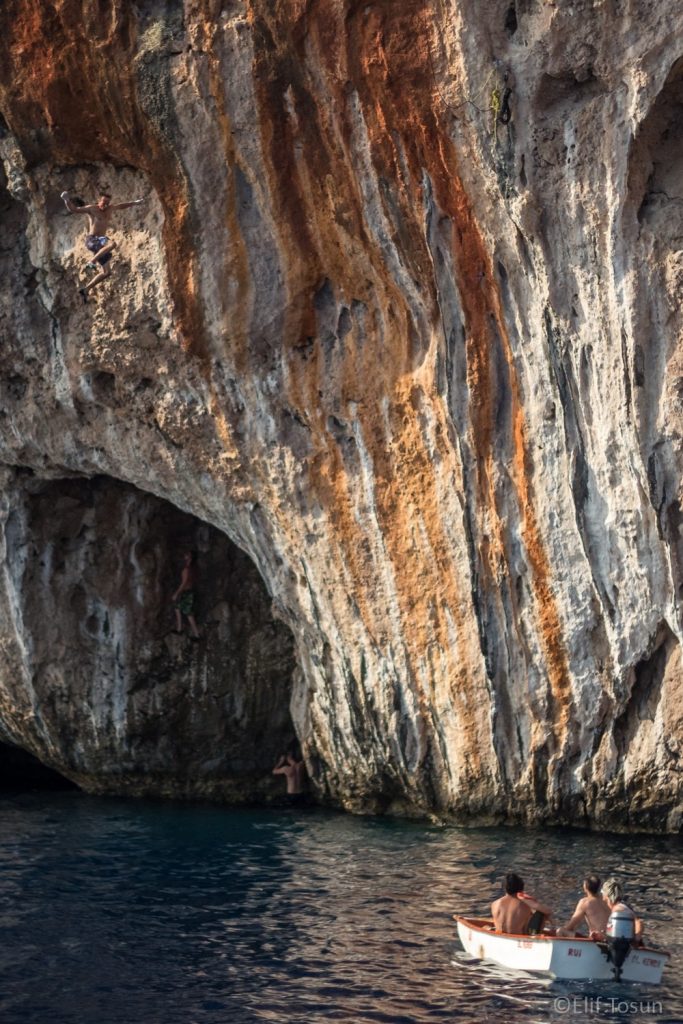
Olympos DWS.
As of December 28th, 2017 visa restrictions between Turkey and the United States have been lifted. A visa-on-arrival can be purchased for $30 in the airport or other port of entry. Like the Schengen Zone visa in Europe, this visa is valid for 90 days within a 180-day span.
If you fall in love with the country, like I did, it’s possible to stay long term legally. For many nationalities, especially for Europeans and North Americans, it’s relatively easy to get a six or twelve-month Ikamet (residence permit) to be a tourist.
Safety
Turkey has a long history of tumultuous political events such as the attempted coup d’état in July 2016. Nevertheless, most of the country is an enjoyable place to travel.
As a rule, travelers are advised to avoid the southeast and areas bordering Syria. Luckily, most of the climbing is in the safest parts of the country.
Enrolling in the State Department’s Smart Traveler Enrollment Program (STEP) can help you stay updated on the ever-changing policies and relevant events. Recent events have soured the already strained relationship between Washington D.C. and Ankara. In my experience, Turkish citizens readily understand that a passport holder might not agree with all of the policies of their government.
Language
Merhaba! Hello!
Tourism industry professionals are ready and willing to communicate with foreigners, so it’s not strictly necessary to learn Turkish beforehand. Nevertheless, it is greatly appreciated when foreigners use or try to use this unique language.
- Merhaba = Hello
- Görüşürüz = See you later
- Teşekkür ederim = Thank you
- Lütfen = Please
- Hoş Geldiniz = Welcome
- Tuvalet nerde? = Where’s the bathroom?
- Evet = Yes
- Hayır = No
- Pardon = Sorry and excuse me
While written in the same alphabet we use to write in English, there are additional letters and some different pronunciations that can make reading Turkish tricky.
- Çç = ‘ch’ as in ‘chipped route’
- Şş = ‘sh’ as in ‘sharp end’
- Ğğ = no sound
- Iı = ‘eh’ or ‘uh’ as in ‘arete’
- İi = ‘ee’ as in ‘cut feet!’
- Öö = ‘ur’ as in ‘more slack’
- Üü = ‘u’ as in ‘crux’
Climbing area overview
Aladağlar Milli Parkı (Crimson Mountains National Park)
- Type of climbing: Alpine, multi-pitch, and sport
- Best months: March to December for sport climbing. May to November for multi-pitch.
- Guidebook: A Comprehensive Guide to Aladağlar: Climbing, Trekking, Ski Touring by Recep Ince and Zeynep Tantekin
- Number of routes: 450 sport and 65 multi-pitch (trad, mixed, and alpine sport)
- Route recommendations: Ali Baba 5.10d/6b, Suskunlar 5.12c/7b+, Parmakkaya Classic 5.9, Pamuk Prenses, Uç Müz 5.13b/8a

The birthplace of Turkish climbing is named after the red glow of the mountains in the sunset. Facing east, it looks like a desolate moonscape. Yet, the streams down at the base of the mountain range are flanked with apple, apricot, and pear orchards. The region has over 60 mountains over 3,000m.
Kazıklı Ali Vadisi has over 350 phenomenal sport routes on conglomerate limestone. Grades range from 5.9/5c to open projects. There’s a lot to do between 5.10a/6a and 5.14a/8b+. The name of the gorge translates to ‘Ali with sticks’ Valley’. It was named after Ali, a villager who climbed a crack by jamming in long sticks to gather honey from a hive at the top: Ali with sticks’ Valley.
The crack is just on the right side of the Ali Baba sector as you descend into the gorge. There is a lot of diversity of climbing style; from 35m vert routes on the Dergah wall, power crimping on Smith Rock-esque nobs in the Krallar Vadisi (King’s Valley), to steep pockets in the Podium. Sarkaç and Podium offer some of the best of the upper grades on pocketed limestone. What’s even better is these sectors are a quick 15-minute walk apart!
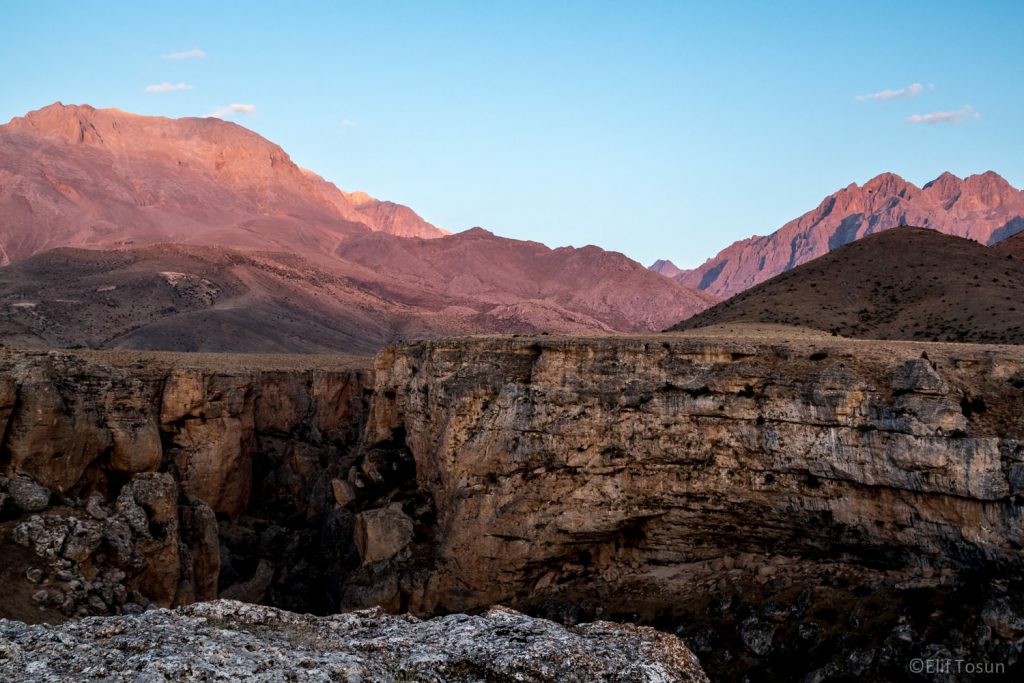
Podium Sector in Aladağlar.
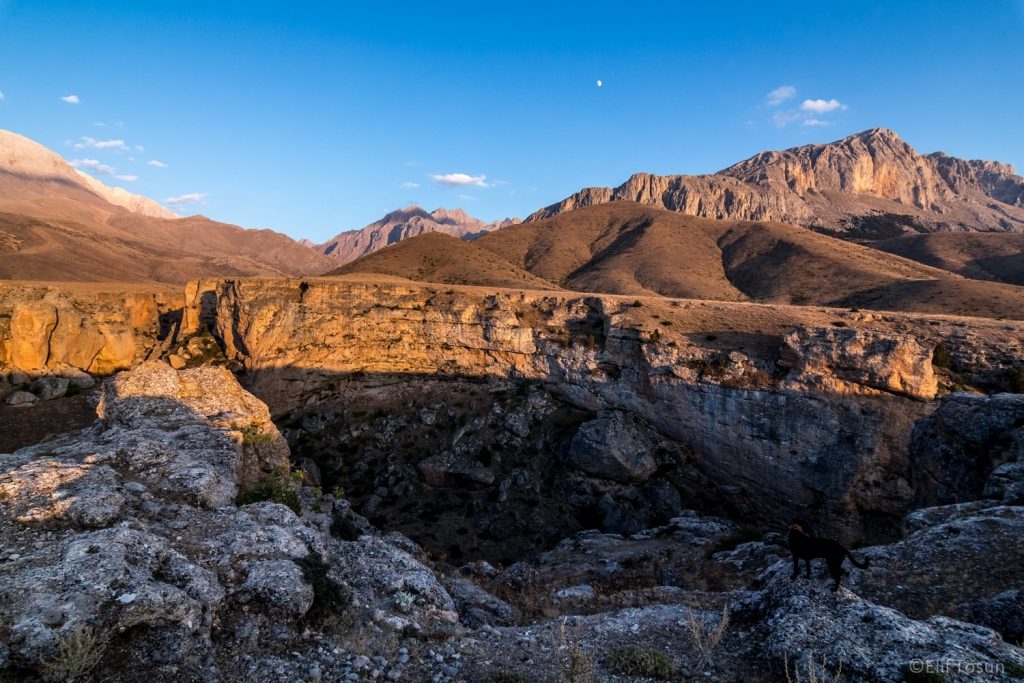
Preparation and grocery shopping
This is a rural region with small villages. Specialty items like non-dairy milk aren’t available in the area. Çamardı is about 5 miles from the Aladağlar Camping and Bungalow. The chain store A101 is open 7 days a week (even mid-day on Friday) and is a good place to buy dry goods and refrigerated items.
To truly get everything you need, it’s always worth it to grocery shop on market day. Make sure to go earlier in the day, because the market will relocate to another village for the afternoon. There’s a specialty milk, cheese, yogurt, and egg shop on the main street in town as well; Emre the owner collects milk from villagers and prides himself on selling healthy and sustainable products.
Camping
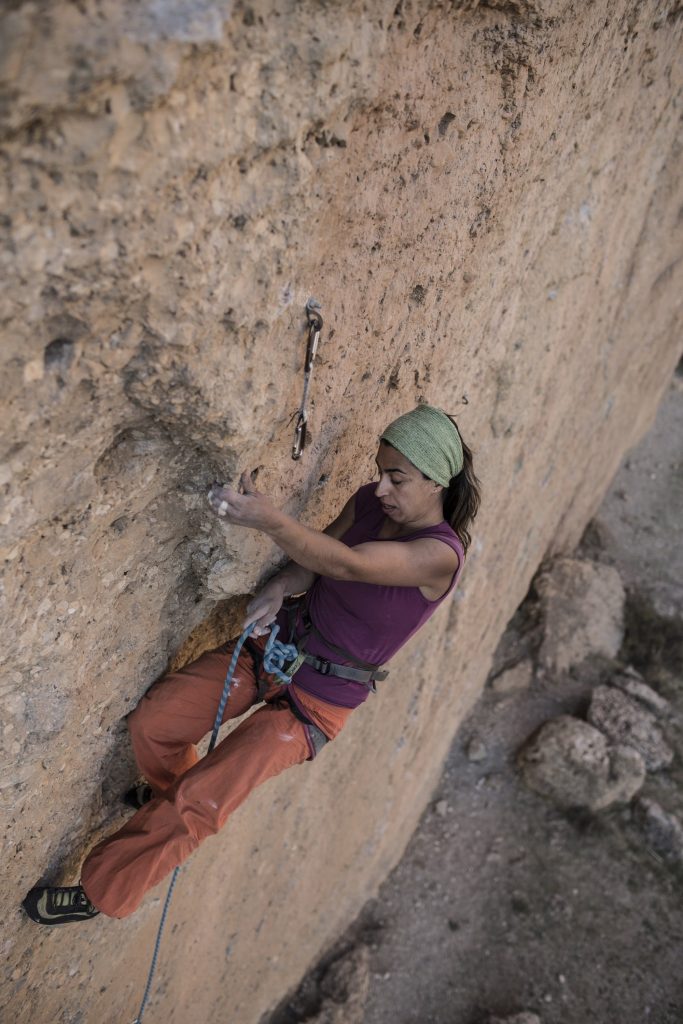
Zeynep Tantekin climbing in Kazıklı Canyon in Aladağlar.
Recep Ince and Zeynep Tantekin are the two main developers of the area and have a climber’s camping and bungalow site in Marti Mah, off the road to one of the main entrances to the national park and Kazikli Ali Vadisi. Check out their website: www.aladaglarcamping.com. There is also a primitive campground just inside the park entrance (small fee to camp), Sarımehmetler.
Getting there
Aladağlar is in the Niğde province, centrally located between the cities of Niğde, Kayseri, and Adana. While not strictly necessary, having a car makes climbing in the region much easier. The nearest airports are in Adana and Kayseri. Major bus companies go to Niğde. From Niğde, a local bus goes to Çamardı, the nearest town.
Rest day activities
Relax under apple trees with a book or drive east to see the Gumuşler Monastery, an underground religious site from 800 A.D. and the Kocakaya boulders. There are hiking opportunities galore all across the mountain range. While it’s a longer excursion, the famous fairy chimneys, cave houses, and ancient Greek churches of Cappadocia are 1.5 hours north of Çamardı.
Kapıkaya (Head Rock)
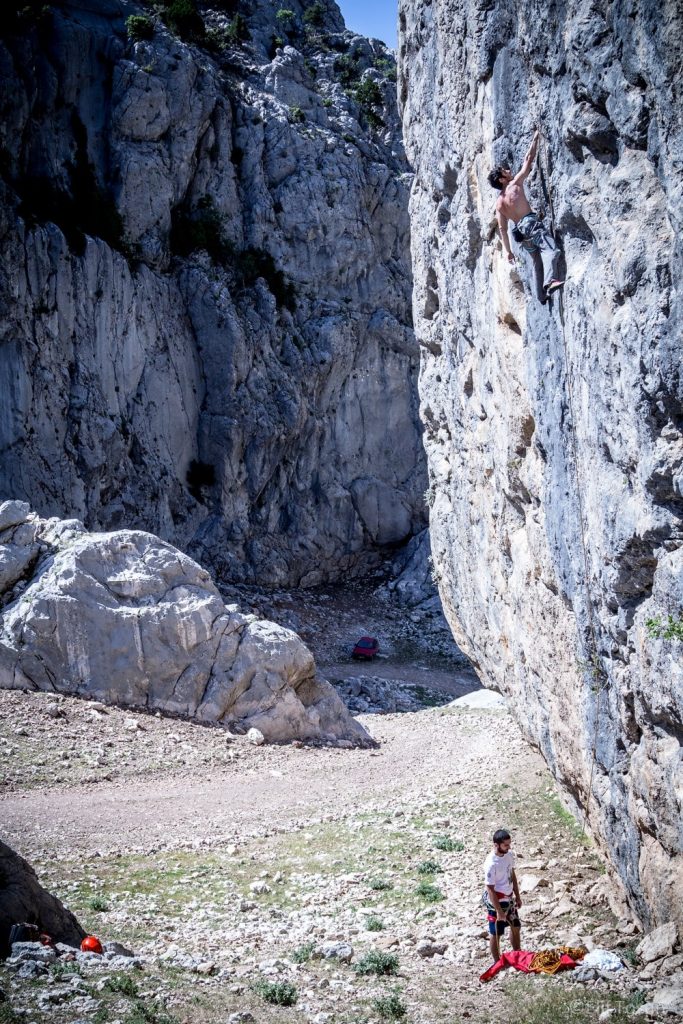
- Type of climbing: Sport; both single and multi-pitch
- Best months: April to October
- Guidebook: Isparta Rock Climbing Guide for both Kapıkaya and Yazılı Kanyon is available from the Bureau of Culture and Tourism in İsparta (İl Kültür ve Turizm Müdürlüğü), sponsored by Kayadaki Eller
- Number of routes: 100+
- Route Recommendations: Kıştepsi 6c+, Kapıkaya multi-pitch
The drive to Kapıkaya from Antalya is flanked by so much undeveloped limestone you may never even make it to the mountain.
Recently developed, Kapıkaya and Yazılı Kanyon have single and multi-pitch climbing. Kapıkaya, meaning head rock, overlooks pine forests and deep limestone canyons. Climbers usually camp in the unexcavated ruins on the south side of the pass. The climbing is dispersed, with bolted routes on both rock formations. The routes on the eastern wall of the pass are some of the toughest individual pitches, but the namesake ‘head rock’ offers the most rewarding view from the summit.
A perfect destination for the climber prioritizing peaceful seclusion, exposure, and history. The atmosphere at Kapıkaya makes this truly stand out as a destination. Unexcavated ruins for a campsite truly allow the imagination to run wild; why did they build in this seemingly impractical location? Fall asleep dreaming of battles in the past. Images taken by Elif Tosun, a photographer and climber from Ankara, do a much better job than I at expressing the uniqueness of this landscape.
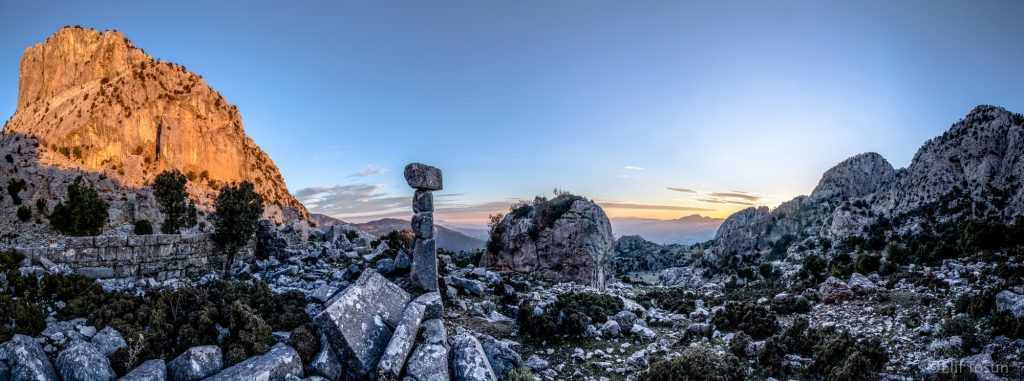
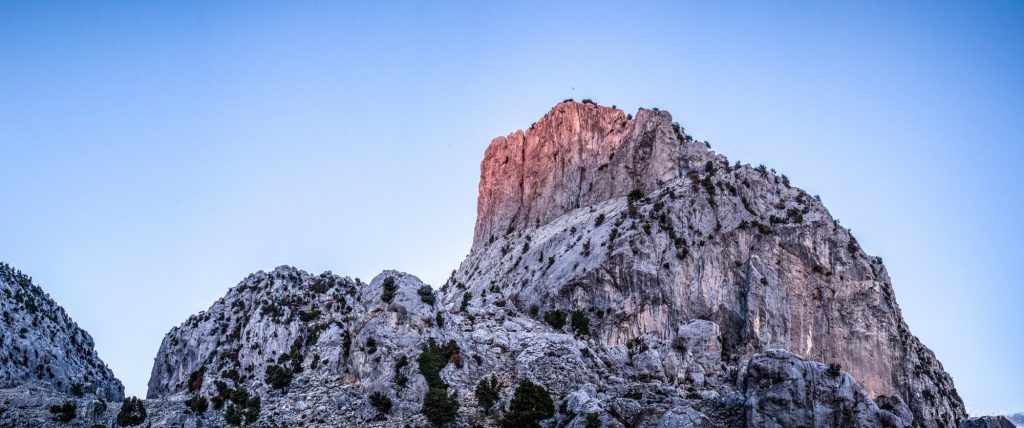
Preparation and grocery shopping
The closest cities are Antalya and Isparta. Bring everything with you!
Camping
Free camping amid ruins is probably as good as it gets. There’s a spring that locals drink from, but a water filtration system might be a good idea for those who worry about such things.
Getting there
From İsparta, follow D685 south towards Antalya and turn left to Güneyce Village. Follow signs for Kapıkaya. The dirt road rambles up the north side of the mountain, past a spring and a shepherd’s hut, and then through a windy pass. Find it on the map at +37.651716, +30.756873.
Rest day activities
Explore and swim in the neighboring Yazılı Canyon, where there are another 30 routes.
Kaynaklar (Many Springs)
- Type of climbing: Single pitch sport
- Best months: March through June and September through November
- Guidebook: Two new guidebooks by authors Doğan Palut and Zorbey Aktuyun are in progress and a booklet covering most routes can be picked up from the local outdoor sporting goods stores.
- Number of routes: approximately 230
- Grade range: 5.8/5a to 5.14a/8b+
- Route recommendations: Çaylak 5.10b/6a, Çin Mahallesi 5.11a/6b+, Karşıyaka 5.11d/7a, Krokodil 5.12a/7a+, Afrodizyak 5.12b/7b, Symbolic 5.12d/7c, Zerdüşt 5.13c/8a+, Odin 5.13c/8a+
Kaynaklar is a short bus ride from the city of Izmir. This crag grew on me steadily and I left with nothing but a fondness for the area. One of my favorite things about Kaynaklar is that you don’t need a car to climb here.
The Dokuz Eylül University organizes an annual climbing festival in the spring that was attended by about 3,000 people in 2016. This crag is underwhelming compared to other world class destinations in Turkey, but if you’re in the area it is absolutely the best place to climb.

Preparation and grocery shopping
The climbing and camping area is within walking distance of the village, which has basic groceries and a handful of restaurants. Bring everything else from Izmir. Spring water comes out of a pipe by the road as well as uphill from the main field for camping.
Camping
Camping is permitted in and around the field 300m below the cliffs. Tip: head upstream to pitch your tent.
Getting there
Kaynaklar is the name of the village on the outskirts of the Buca district in Izmir. From the village plaza with ancient trees, follow the stream uphill, keeping it to your left. After you pass a spring, cross over the stream on a bridge and bank right. Follow the stream again up to a clearing. Some of the crag should be visible above the trees to the east. Find it on the map at +38°21’50”, E 27°17’52”.
Rest day activities
Treat yourself at one of the restaurants in the village or head into town to visit the museums learn about the Greek, Roman, and Ottoman history of Izmir.
Sarıkaya (Yellow Rock)
- Type of climbing: Sport and a touch of trad
- Best months: April through October
- Guidebook: Sarıkaya Rock Climbing Guide
- Number of routes: 125
- Grade range: 5.9/4 to 5.13d/8b
- Route recommendation: Mercimami 5.9/5b, Yaz 5.10/6a, Tarla Blues 5.10c/6b, Demir Yumruk 5.11d/7a, Araf 5.12b/7b, Kybele 5.12c/7b+, Tango de Roxanne 5.13a/7c+, Dharma 5.13b/8a, Niobe 5.13c/8b
This newer crag is still being bolted. Development is led by local Zorbey Aktuyun, so check in with him if you want to put up a line! The routes are long, up to 50m. Sarıkaya is an ideal place to climb on high quality, unpolished limestone in the summer months.
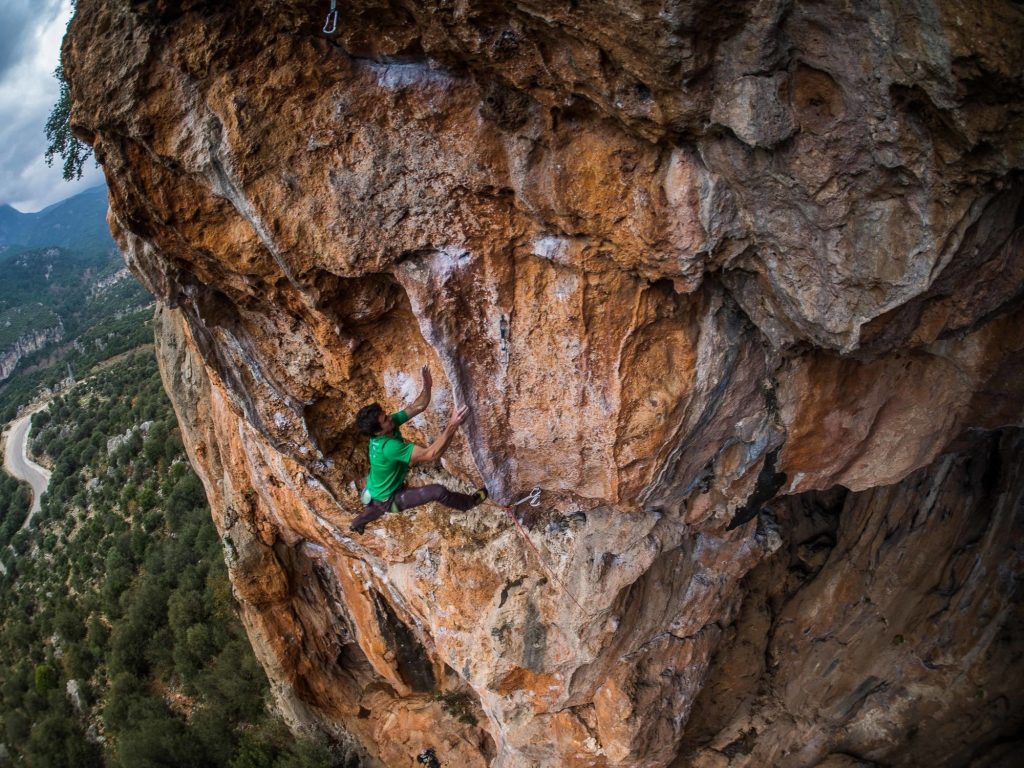
Anaconda 5.12d in Trebenna. Photo: Dylan Connole
Preparation and grocery shopping
Climbing is 16km from Izmir, a fully functional city.
Camping
There is no place to camp or climber-specific accommodations. It’s best to stay in a guesthouse or hotel in neighboring Izmir or Manisa.
Getting there
You’ll need a car for this crag. Leave Izmir on the road towards Manisa, stopping at Sarıkaya. You can find the parking at N 38°34.179′ E 27°19.192′.
Rest day activities
Manisa and Izmir both have a plethora of sights to see. A slightly longer trip in the car can take you to any number of beaches on the Aegean Sea.
Geyikbayırı (Goat Hill)
- Type of climbing: Sport
- Best months: September through April
- Guidebook: A Rock Climbing Guidebook for Antalya by Öztürk Kayıkçı (2014)
- Number of routes: 1,300+
- Recommendations: Saxophone 5.10d/6b+, Jaja City 5.12a/7a+, Power Slave 5.12b/7b, Inner Smile 5.12c/7b+, Local Tourist 5.13b/8a, Colonist 5.13c/8a+ … and that’s just one of many sectors!
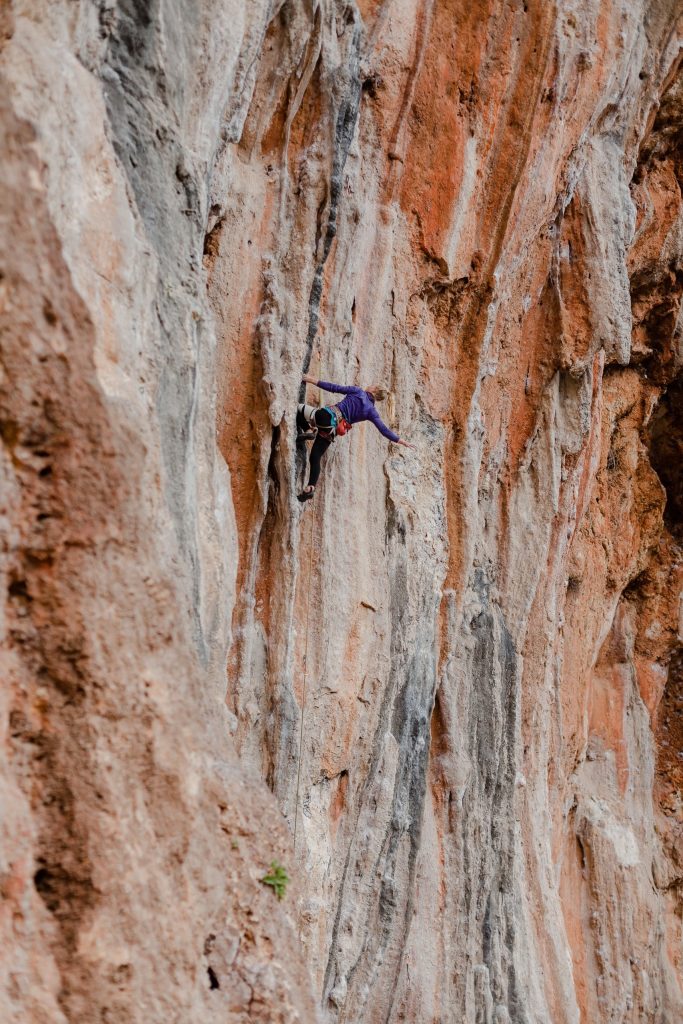
Ja Ja City 5.12a in Sarkıt Sector in Geyikbayırı.
Geyıkbayırı is in many ways the crème of the crop.
There are about a thousand routes within walking distance, a diverse and stable climbing community, and affordable campsites and bungalows. Best of all, Geyik has that Mediterranean limestone we all dream about. It’s just outside of the Mediterranean city of Antalya, which has enough public transportation to make a car-free climbing trip possible. It also makes a great base camp: Olympos and Çitdibi are both a short drive away. Lots of information about this area is available elsewhere online, so I’ll keep it brief.
Preparation and grocery shopping
It’s best to do your shopping in town before arriving in the climbing area. Hurma, the district of Antalya closest to Geyik, has both. Çakırlar, the next village up the hill towards the climbing, also has an A101. Akdamlar, even closer to the climbing, has a market on the weekend frequented by climbers, locals, and local climbers (careful not to get overcharged).
Camping
There are numerous climber-specific accommodations; Climber’s Garden, The Land, Rido Camping, Kezban’s, JoSiTo, and Peak Guesthouse. Most have both bungalows for rent and places to pitch a tent. For those on a budget without camping equipment, you can also rent a tent!
Getting there
Antalya is a large city with an airport (Hava Liman) and bus station (Otogar) and frequent buses that connect the two. The climber accommodations are a kilometer before the village and have signs on the side of the road. There is a bus route connecting the Otogar to the village of Geyikbayırı three times daily (morning, afternoon, and evening). Hourly buses turn around in Akdamlar, a few kilometers before the climbing, stopping around 7:30 pm.
From the Otogar, take the TK-51 bus to Akdamlar or find one of the mysterious busses (they leave town three times a day) that’ll take you all the way! Ask around to find out where exactly it picks up passengers, as it does not go into the bus station. Bus numbers and times are subject to change, but there will be signs announcing the destinations on the front of the bus. Don’t be afraid to ask for assistance! Writing down the name of the village (Çakırlar, Akdamlar, Geyikbayırı) and showing the names to a bus driver can be very effective.
Rest day activities
Open-air market, Turkish style brunch, hammam, museums, swimming in the Med, and on and on.
Çitdibi (Tufa Madness)
- Type of climbing: Sport
- Best months: late August through December; April through June
- Contact: Duygu and Tobias Haug
- Guidebook: A Climber’s Guide to Antalya by Öztürk Kayıkçı (2014); additional topos available online at masalrefuge.com.
- Number of routes: about 87
- Route recommendations: Woman in Paradise 5.11c/6c+, James Caro Wedding Present 5.13c/8a+
Developed by the Duygu and Tobias Haug, Çitdibi is the future of climbing in the Antalya region. The video of the 2014 Petzl Roctrip features ‘Geyikbayırı’, but the footage is actually of Çitdibi.
The long wall provides a variety of types of climbing, but it’s really those tufa lines that draw the most attention. The bulk of the routes are between 5.12d/7c and 5.13d/8b and there are many routes over 35m. Bring your endurance and a long rope.
Preparation and grocery shopping
Bring everything! In the grand scheme of things, it’s not all that far from town. Grocery deliveries can also be arranged at the Masal Refuge.
Camping
The Masal Refuge, a short walk below the cliff, has beautiful cabins for rent and a nice place to pitch a tent. The common kitchen has couches, a woodstove, and a fireplace on the porch. This is really the only option for staying directly at the crag.
Getting there
The crag is about 40 kilometers from Antalya’s city center and 25 kilometers from Geyikbayırı. Unlike Geyikbayırı, a car is the best way to get to the Masal Refuge. JoSiTo’s and Masal Refuge offer a variety of pickup/drop-off shuttle or car rental services. From Masal’s Refuge, the cliff is a 10-minute walk.
Rest day activities
Besides hiking, mountain biking, and soaking in the spectacular view, most activities are driving distance from the Masal Refuge.
Bafa Gölü (Bafa Lake)
- Type of climbing: Bouldering
- Best months: October through April
- Number of boulders: about 1000
- Grade range: V0/3 to V14/8b+
- Guidebook: Bafa Gölü Bouldering by Zorbey Aktuyun
- Recommended problems: By the Way V3/6a+, Rakı Hangover V5/6c, Teknik Eziyet V6/7a, Turk is the New Font V7/7a+, Prince of Darkness V8/7b, Human Robot V10/7c+
B is for bouldering in Turkey too; Bafa offers the best bouldering in the country.
Development in Bafa, which began in 2003 on a trip led by Zorbey Aktuyun, has happened more slowly than for the sport areas. As a side effect, the local villagers are very friendly to climbers and visitors. The rock is a bit skin intensive and can be techy or powerful, steep or slab. Bring your crimpers.

Preparation and grocery shopping
Basic supplies can be purchased in Kapıkırı, the closest village. Bring specialty items and long-term supplies from a neighboring city such as Izmir or Bodrum.
Camping
The Karia Pansion and the Selenes Pansion both warmly welcome boulderers. Crash pads are available for rent as well.
Getting there
The climbing is on the eastern side of Bafa Lake near the village of Kapıkırı. Bodrum and Izmir are the two closest airports. If arriving by car, drive north from Bodrum or south from Izmir on highway D525 to the town of Bafa Merkez. Turn east at the sign to Kapıkırı Koyu, approximately 11km. Buses and minibusses cover the entire area as well, though the last section to the village may not have frequent service.
Rest day activities
Explore the ruins of ancient cities and villages. This region has rich and extensive history that has been traced all the way back to the stone age. The ruins spread amongst the rocks are a destination in of themselves. In the surrounding region, there are monasteries, castles, and seemingly endless historical sites.
Watch the Petzl RocTrip episode to Bafa Lake:
Check out the film by Turkish climber Uğur Yılmaz:
Now to you
These destination guides are only made possible through the feedback from climbers like yourself. Are we missing some beta? Have anything extra to share? Leave your feedback in the comments below.
Have your own destination beta? Submit a destination today.
Explore More
Related articles you'll loveOur 40+ most popular articles ever
Today’s Best Rock Climbing Gear Deals
200+ rock climbing videos
A Tale of 10,000 Crags: Guide for How (and Where) to Climb in Spain
Climbing Destination Guide: Datca, Turkey
How to Maximize Your Time on Rock When Traveling Alone
All climbing destination guides
Free eBooks for rock climbing training, technique, and more

